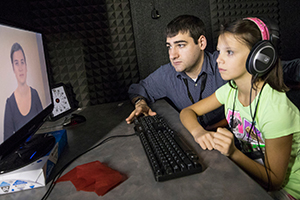
VIRTUAL REALITY MAY HELP SMOOTH OUT DISCONNECTS BETWEEN VISION AND HEARING
02/21/2023

|
| A young male researcher sits next to a young female research participant in front of a computer in a sound booth. The girl is wearing headphones. On the computer screen is a video of a young woman speaking directly to the research participant. |
AUCD's network of Intellectual and Developmental Disability Research Centers (IDDRCs) consists of 16 Centers. Fifteen Centers currently receive funding from the Eunice Kennedy Shriver National Institute for Child Health and Human Development (NICHD). IDDRCs contribute to the development and implementation of evidence-based practices by evaluating the effectiveness of biological, biochemical, and behavioral interventions; developing assistive technologies; and advancing prenatal diagnosis and newborn screening.
Sensory inputs that neurotypical people perceive as simultaneous are sometimes perceived as separate in autistic individuals, such as the sight and sound of a bouncing ball.
Vanderbilt Kennedy Center (IDDRC, UCEDD, LEND) researchers are now closely examining the ways autistic brains perform when it comes to processing and merging visual, auditory, and tactile information. The step may lay the foundation for interventions to improve sensory integration.
“We know there are differences in the way in which sensory information is processed in autistic individuals. We are looking inside the brains of these people to find areas that are functioning differently and tie those findings into the differences we often observe in peoples’ behavior,” said neuroscientist and VKC investigator Mark Wallace, Ph.D., also a professor of psychiatry and behavioral sciences at Vanderbilt University Medical Center.
Wallace likened the experience of asynchrony in auditory and visual inputs to the experience of watching a badly dubbed movie.
For years, autism research has focused on three areas of weakness: communication, social interactions, and restricted interests and repetitive behaviors, Wallace explained.
“At the same time, important sensory processing differences were under-recognized in autism research, although parents were well aware of their children being either hypo- or hyper-responsive to certain external stimuli,” Wallace said.
“We live in a world in which we are bombarded with sensory information,” Wallace said. “Visual information comes in via the eyes; auditory information arrives via the ears. For an event in the world that generates both visual and auditory energy — think of a bouncing ball – the brain uses the proximity in time between then to say that this event is one event, not two.”
Usually, the brain unites the inputs in time during what he described as a “temporal binding window.”
In prior work, Wallace and his collaborators have shown such temporal binding windows to be larger in autistic individuals, which can cause their brains to perceive the sight and sound of the ball bouncing as two events instead of one.
The ramifications of having a brain that doesn’t properly synchronize different types of sensory inputs are many, including difficulties learning.
“What kids do when they learn to read is to rapidly and accurately match the auditory pieces of the words, the phonemes, with their corresponding visual representations, the visemes,” Wallace said. “If there is a larger temporal window, this creates a fuzzy representation. They don’t know which phonemes belong with which visemes.”
Social interactions can also prove challenging to those whose brain don’t coordinate sights and sounds rapidly.
“For autistic children, we talk about problems in language, communication, and social interaction,” Wallace said. “Are we thinking about these problems too late? Do the difficulties arise because they are building up different language and social representations in their brains as a result of how they are integrating sensory information?”
Wallace said his previous discovery made a decade ago illuminated the problem autistic children have in combining sights and sounds in relation to time. With his recent award, Wallace and his research colleagues will build on this crucial insight.
First, they plan to characterize differences in the ways that neurotypical children and those with autism combine sensory information in the spatial dimension. Second, they will identify brain areas that are associated with these spatial processing differences.
To support the research, Wallace and two colleagues recently received one of the 2022-23 Nicholas Hobbs Discovery Awards and Director’s Strategic Priorities Grants from the Vanderbilt Kennedy Center.
Tiffany Woynaroski, Ph.D., an assistant professor in the Department of Hearing and Speech Sciences at the Vanderbilt School of Medicine, and Nilanjan Sarkar, Ph.D., a professor of Mechanical Engineering at the Vanderbilt School of Engineering, are the collaborators.
“We are partnering to build out virtual-reality paradigms to more effectively test whether there are these spatial processing differences and, if so, the nature of those differences,” said Wallace, who added that he finds this aspect of this work very exciting.
His team wants to use virtual reality not just as a tool for research but also, possibly, as therapy.
“We plan to explore using it to help autistic children become better at binding information from sights and sounds. Then we can see if that improvement cascades into improvements in social communication,” Wallace said.
This story originally appeared in Discoveries in Medicine.